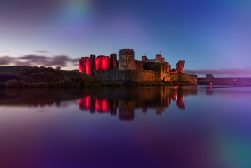
This a guest post on useful Luminar Tips you can use when editing your photos, by photographer and writer Dawn Gilfillian.
Do you want to create amazing images in post-processing, but find you lack the time? The impressive Luminar image editing software can help make your images pop, with just a click and a slide.
In this article, we’ll take a closer look at Luminar’s Accent AI 2.0 filter, the RAW Develop filter, Workspaces, Looks, and LUTs. I’ll also share some tips and tricks on how to use them. If you are new to Luminar, you should check out Getting Started with Luminar 4 tutorial.
Skylum recently revamped the Accent AI filter, making the artificial intelligence that drives it more responsive and powerful, so we’ll take a look at that first of all.
(If you haven’t already got a copy of Luminar, check out this Luminar 4 Discount.)
Luminar Tip #1: Use the Accent AI 2.0 Filter
If you are looking to save some serious time on your editing, Accent AI 2.0 should be your first stop.
This is the second generation of the filter driven by artificial intelligence, and it has been improved to give better recognition of faces and objects, to give a more authentic-looking image.
Luminar’s Accent AI 2.0 fixes tone, details, exposure, contrast, color and more, all with a single click of the slider.
On the image above, you can see the difference in the before and after split screen.
This was with the slider up at 100%, something I wouldn’t normally do, but I wanted to show you the changes it has made.
It’s really lifted the shadows and brought the colors out, which I think is impressive for a one-click edit!
Tip #2: Try the RAW Develop Filter

RAW develop before and after split screen
Luminar’s RAW develop module has everything you need to take your RAW files from dull to dazzling.
It has all the tools you need in a RAW developer: white balance, shadows, highlights, contrast, clarity, etc.
You’ll find the RAW develop module on the right-hand side of the screen in Luminar:

RAW develop module – adjustments menu
As you can see, I have adjusted the shadows, clarity, exposure, and contrast on this image in order to lighten and brighten it up.
You can also add other filters and adjustments to your RAW developed image, and I boosted the hue/saturation slider a little.
The other handy part of the RAW develop module is the Lens tab. Go on this tab, and you can fix chromatic aberration, lens distortion and also devignette and defringe your RAW image:

Lens tab in the RAW develop module
Tip #3: Find the Workspaces That Suit Your Workflow

Luminar workspace menus
One of the handiest tools in Luminar is the Workspaces menu. It saves tons of time because you don’t have to go hunting through lots of menus to find the filter that you need.
This menu groups tools together according to the type of editing you want to do. So, for instance, the Quick & Awesome workspace contains only what you need to make your editing…well…quick and awesome!
If you are into drone photography, you will find all the tools you need to edit your images in the Aerial Photography Workspace, and professionals will find a whole host of tools in the Professional workspace, including RAW develop, the Curves tool, and Advanced Contrast.
You can also create your own custom workspace that contains the filters that you use most often. Next time you’re in Luminar, be sure to check out the Workspaces.
Tip #4: Enhance Your Image with a Luminar Look

Luminar Looks – before and after split screen
Luminar Looks are a bit like filters, and they can be added to your image with just one click. They can make a big difference, as you can see in the image above.
I had the strength up at 100% for this, but you can adjust the slider to enhance your image as little or as much as you like.
There’s a large range of Luminar Looks to choose from, with categories ranging from landscape, street, portrait and dramatic. You’re sure to find one to fit your image perfectly or you can check out the best Luminar presets here.
Tip #5: Add a LUT to Your Image for a Finishing Touch

Before and after split screen with LUT mapping
LUT’s (lookup tables) have been used for a long time in the film industry for giving a certain type of atmosphere or color grading to the film or video. T
he great thing is, they are now gaining popularity in the photography world too.
To effectively add a LUT, you need to do your adjusting and other editing first, like fixing exposure, etc. Then you apply the LUT as the final step before sharpening and exporting.
There are lots of built-in LUT’s to choose from in Luminar, and all will give a different effect to your image.
The one I added above was called Kodachrome 3, and I adjusted the slider to around 48, as 100 was too strong.
The great thing about LUT’s is that you can find lots of free ones on the Luminar marketplace, or elsewhere on the internet, and upload them to Luminar.
Final Words
I hope these Luminar tips have been helpful to you, and that you decide to try them out for yourself.
Life is short, so why spend time sitting in front of a computer, when you could be uploading your newly-enhanced images to your website or social media?
Leave me a comment if you have any questions ;-)















